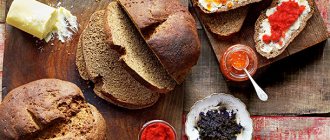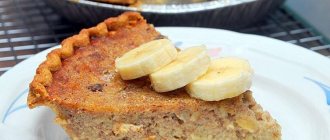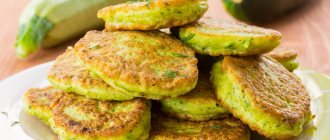The basis of the basics, the baker's faithful assistant, friend - this is how you can call Mother natural sourdough. In ancient times, it was passed down from generation to generation, from mother to daughter. It was cherished like the apple of our eye, because natural leaven is alive and the bread that we bake with it is alive. And like any pet, sourdough requires love. Love it and you will receive in return a wonderful product - yeast-free bread!
The more you learn about natural sourdough, the more and more questions appear than answers. Seems like a baker should be a chemist
to understand the whole process that happens in a bowl of flour and water.
But daily bread baking experience and a little intuition tells me that by baking bread and feeding the starter, it lives for a long time, and pleases me with its slightly sour fruity aroma
.
There are two phases in the life of natural sourdough: the breeding cycle
, lasting from 6 to 10 days, and a maintenance cycle.
The breeding cycle starts the process of extracting wild yeast
contained in flour and lactic acid bacteria, which then create the unforgettable taste of Lithuanian bread.
After adding water to the flour, after 24 hours the water-flour mixture begins to grow. This indicates that gas appears in the bowl and the metabolic process begins. , favorable types of bacteria gradually begin to dominate in it.
.
to feed his brainchild
at regular intervals, like any living creature. And the result will make itself felt. The starter gains strength so that the baker can bake real yeast-free bread with it.
Bread made with natural sourdough will vary
, since wild yeasts and bacteria from the environment
of different regions differ greatly
. Therefore, if you receive a starter from Germany, how long will it take you to get your regional one, due to the presence of different water and a different grain composition in the flour. And this is what will give your bread its unforgettable aroma and taste. I repeat, typical for your region!
Sourdough starter - basic information
Growing sourdough starter is a difficult task. However, it does not require any special products or skills; you only need flour, water, patience and time. There are many recipes for making sourdough, but usually the simpler the recipe, the better it is. The recipe for sourdough bread can be found on our website. In the future, you will need to be patient and persevering and not to despair; beginners often have failures.
Day 5
Fifth feeding - the starter is four days old.
Over the past 24 hours, the starter should have acquired an important skill: it should begin to “walk,” that is, rise and fall.
In addition, the starter should have a pleasant smell (something berry-wine-herbal-fermented milk), it bubbles vigorously and can increase in volume by 2-2.5 times. When fertilizing, we will divide it again, transfer half of it into a clean jar (the remaining half is not used again), pour water into it in a volume equal to the volume of the starter, and add sifted flour with siftings to the consistency of thick sour cream, cover and place in the usual place.
Wheat sourdough for dough
But if someone wants to bake bread 100% from wheat, then they can make a sourdough starter from whole grain wheat flour or use rye sourdough as a “starter”. Unfortunately, wheat starter is more difficult to store for long periods. Therefore, it is recommended to grow this wheat product only for a specific type of baking, for example, preparing sourdough, wheat sourdough for pies and sourdough pizza dough.
How to choose the right flour?
To prepare high-quality acidified dough, it is better to use high-quality flour. It is worth considering that the high price of flour does not always prove its quality. You should read the label and make sure it is free of artificial additives. It is worth buying flour from a trusted manufacturer so that it does not contain fungi.
Breeding rye sourdough
Ingredients: whole grain rye flour
- 490 grams,
well water
- 490 grams.
Cooking method:
1 day
: 140 grams of whole grain rye flour + 140 grams of well water, mix well, cover with film and leave in a warm place (24-27°) for 24 hours.
2 day one feeding
: ¼ part of the previous mixture 70 grams + 70 grams of whole grain rye flour + 70 grams of water, mix thoroughly, cover with film and leave in a warm place (24-27 degrees) for 24 hours.
3, 4, 5, 6 days two feedings each
: ⅓ part of the previous mixture 70 grams + 70 grams of whole grain rye flour + 70 grams of water, mix thoroughly, cover with film and leave in a warm place (24-27°). Carry out two feedings a day with an interval of 12 hours.
It is customary for Lithuanian bakers to lightly sprinkle the surface of the starter with rye flour.
. This contributes to the supply of additional nutrients to the starter and also prevents “weathering” of the surface.
On day 7 the starter is ready
. It’s not strong yet, but you can bake bread with it.
The smell of sourdough for dough without yeast
The smell of this product varies depending on the degree of ripeness and the type of flour used in preparation. On the second day you may notice a slightly sour smell. Sometimes you can smell quite unpleasant and even the smell of acetone. After a few days, a ripe, ripened product smells sweet and sour; this smell is similar to the smell of balsamic vinegar.
Color
The color also changes with the degree of ripening. At first it will be gray (especially in a product made from wholemeal rye flour). Every day it will become more and more light brown, beige. Such changes are quite normal.
Bubbles
On the second day, the liquid starter begins to release the first bubbles. Their quantity largely depends on the temperature at which you store the mixture. The warmer it is, the more bubbles there are. But even if there are not too many of them, this means that nothing bad is happening. You must continue to feed her, that is, add more flour and water according to the recipe.
How to tell if your starter has gone bad
Unfortunately, sometimes this happens despite a sincere desire to preserve it and all efforts. If mold, black, red or green water appears on the surface, this means that the product has spoiled and should be thrown away immediately. It is best to start the process again and thoroughly wash and scald the jar with boiling water.
When homemade starter is ready to use
Some people believe that homemade yeast starter is ready for its first use after three days of cultivation. However, it is still worth waiting for approximately 6-7 days to be absolutely sure that the bread will succeed. Keep in mind also that the younger she is, the less mature and stable she is. Therefore, especially the first baking does not always end successfully. In this case, you can first add half a teaspoon of dry or fresh yeast per bread.
Day 2
After checking the starter, we should find:
- bubbles and something like foam appeared on the surface (this may not be the case)
- the sourdough smells bad
- the starter became more liquid than we left it.
The starter may rise on the first and second days, or it may not rise - it all depends on what microorganisms are in it. Both are within normal limits; neither one nor the other is a sign of her readiness.
The fact is that in the first days of fermentation, all types of microorganisms that were in the flour multiply in it, could get into it with water, from the air, from our hands. Among them, of course, there are also pathogenic microorganisms, even Staphylococcus aureus, and it is clear that the products of their vital activity can have a smell that is very far from pleasant.
Some of them may turn out to be active gas-formers, hence the rise of the leaven in this phase of elimination, which is therefore called, quite deservedly, the phase of putrefactive fermentation.
However, thank God, in parallel with the pathogenic one, the beneficial sourdough microflora we need develops in the sourdough - first of all, lactic acid bacteria , secondly - yeast (note that only acid-resistant types of yeast can take root in sourdough).
Lactic acid bacteria secrete organic acids that have a strong antibacterial effect (acetic acid, for example), and other antimicrobial and antifungal substances; These substances accumulate in the leaven and gradually make the vital activity of harmful microorganisms impossible, since in conditions of such high acidity, in general, almost no one can survive.
Lactic acid bacteria are rare beeches and do not want to see almost anyone next to them, except perhaps selected types of yeast, which, by the way, do not include baker's S. Cerevisiae, since they are sensitive to acidity in general and acetic acid.
Thus, the course of the process is also normal in which the leaven rises on the first or second day, then stops rising, and then, after the unpleasant smell changes to a pleasant one, i.e. approximately on the 4th day, it begins to rise again; and such a course in which the leaven initially, in the putrefactive fermentation phase, did not rise at all, but began to rise only after three days.
A sign of the readiness of the starter - and a very important sign, since in the absence of this ability the starter cannot be considered working - is only its rise in the stage of lactic acid fermentation, that is, starting from about the fourth day.
Add 100 ml of water at room temperature to the jar again.
Sift the flour through a sieve.
Add the sifted flour, along with the bran remaining during sifting, into the jar so that you get the consistency of THICK (from this day forward) sour cream. Imagine sour cream from the store with a thickener or non-drinkable yogurt from a jar.
Consistency is another very important success factor: if the starter is too liquid, it will separate and starve, if it is too thick, it will be difficult for it to ferment at room temperature and gain acidity, it is difficult to overcome pathogenic microflora, it is difficult to start “walking”.
Mix.
Cover with gauze/napkin.
Place in a warm place with a temperature of 24-26˚.
Preparing sourdough dough and shaping products
The easiest to prepare is sourdough rye bread or those breads that are mainly composed of rye flour. Due to the insignificant gluten content in rye flour, they should not be kneaded for too long. The kneading lasts only until all components are combined. You can even do this with a spoon. The consistency of this dough should be quite thick.
Bread with a predominance of rye flour, whole grain or coarse rye, or any other similar type is best baked in special forms. Forming such a product is practically pointless and simply does not make sense, since the low gluten content makes it impossible to obtain an elastic consistency.
Rye bread is best and tastes better the day after baking; it needs to sit for at least a few hours to cool completely.
Wheat sourdough bread
The situation is completely different with wheat bread or other baked goods with a predominance of wheat flour. In this case, the issue of activating gluten, which develops during a long batch, is very important. Of course, it is best to knead the bread in a food processor using a mixer with a special hook, at least for several minutes; you can use a bread machine for kneading; bread machines have special modes for kneading. You can also knead by hand, but then the kneading process will take about twice as long.
Degassing of wheat dough
Wheat bread often requires degassing (folding) once it has risen. This happens in the process of folding the dough during proofing 2 and then 4 times to get rid of the released gases.
Day 4
Three days have passed.
The smell is much better. This means that lactic acid fermentation has prevailed over putrefactive fermentation. If this does not happen, the starter should be fed again according to the previous day’s scheme. If this happens, the starter should be divided.
Dividing means preparing another clean jar and planting half of the available amount of starter in it and then feeding only this half. The remaining leaven should be poured out.
This is done primarily to ensure that the microorganisms receive enough nutrition: if at this stage you feed the starter with less nutrient mixture than in a 1:1 ratio, the microorganisms will not receive enough nutrition. If you feed the starter in the specified proportion without dividing it, then the starter, which in this readiness phase - after the 4th feeding - can (and should) increase in volume by 2-2.5 times, will definitely run away from the jar.
So: if the smell has changed from pleasant to unpleasant, you should put half of the starter into a clean jar, add an amount of water equal to the volume of the starter, stir, then add flour (sifted with bran) to the usual consistency of thick sour cream, mix, cover with gauze, put in warm place - and wait for the rise.
Consistency of sourdough bread dough
The consistency of the dough mainly depends on the recipe according to which it is prepared. Often, incorrect consistency occurs due to the high moisture content of the flour (for example, if you buy flour from another manufacturer, as well as the way the flour is stored). Usually we prepare such dough so that it is possible to form bread from it. But it happens that the dough turns out to be too liquid and simply spreads out on the table. Then you should add a little flour, but only enough to get the right consistency. If you add too much flour, the bread will be difficult to knead, dense and crumbly.
It is also important that the dough is slightly sticky immediately after kneading; it should stick slightly to your hands. With each subsequent degassing, we will flour our hands and the table and the dough will take up a little more flour and will no longer be sticky. The less flour we use for kneading, the better our bread comes out. Nevertheless, everything should be within reason.
Wheat flour bread is best the day it is baked, or perhaps the next day. It loses its freshness faster than rye. However, despite this, even after several days, sourdough bread is still delicious.
FOR BEGINNERS ABOUT SOURDOUND (answers to popular questions)
Friends, greetings! Just recently we had a marathon on developing wheat and rye sourdough on Instagram , it was very dynamic, I was left with a lot of different impressions and I also realized that many, especially beginners who started getting acquainted with bread, have a lot of simple questions and answers which could help us better understand sourdough bread and sourdough itself. I decided to make a selection of your most popular and pressing questions about sourdough, its management, proportions, peak state, etc. Go!
We developed starter cultures using an intuitive method, when we monitor the state of the starter and the second stage (feeding after mixing flour and water) is carried out not according to a schedule, for example, the next day, but focusing on the state of the starter. Depending on its activity and smell, the second feeding can occur either the next day or 3-3.5 days after mixing flour and water at the first stage. The participants had many questions related to this; some interpreted the word “sourness” as “rose”, “fermented”, “settled”, “the next day”))) This only strengthened my desire to talk about those important things even more carefully which we are talking about today.
Briefly the derivation scheme. Important: NOT A SCHEDULE, BUT A SCHEME))
Step No. 1: mix 50 grams in a clean half-liter jar. whole grain flour and 50 gr. water (for rye sourdough you need to take rye flour, for wheat sourdough - wheat flour). Cover with a lid and wait for sourness (at 27-30° this will happen in 1-1.5 days, at 25-26 in 2.3-3 days, at 20-22° in approximately 3-3.5 days).
Step #2: ADDED the same amount of flour as in the first stage, i.e. 50 gr. flour and 50 gr. water (for rye sourdough you need to take rye flour, for wheat sourdough - wheat flour). Stir, cover with a lid, and leave for a day. The starter should show more or less noticeable activity, ideally reach a peak, settle and accumulate even more acid in the smell.
Step No. 3 , final: THROWED OUT half and added 50 grams. water and flour (for rye sourdough you need to take rye flour, for wheat sourdough - wheat). Stir, cover with a lid, and leave for a day. The starter should reach its peak, settle, the smell should ideally not have any unpleasant notes, smell like fruit, kvass, dried fruit.
For many, this was exactly how it was, but not for everyone; there were many questions, a lot of things that did not go according to plan and contrary to expectations.
About the intuitive method of raising sourdough
At the first stage, the starter from flour and water develops, one might say, in a standard way: fermentation begins spontaneously in it. Therefore, our starters are called starters of spontaneous fermentation, which arises spontaneously!))
After mixing flour and water, at first nothing happens in the sourdough, it seems that it is not fermenting, only the smell begins to gradually change in shades: first it smells like lost porridge, which they forgot to throw away the second day, then rotten grass (for rye sourdough) and sour food or even vomiting (for wheat). Gradually, bubbles appear in the leaven, the smell increases, then all these signs only intensify and accumulate: there are more bubbles, the smell is even more unpleasant. Gradually, the leaven settles and sourness appears in it, and the unpleasant smell does not go away, the sour note just continues to grow in it.
This is what happens in all sourdoughs made from flour and water , when you just mix them and leave them, but for some the sourdough goes through this entire journey in 1.5 days, while for others it takes a while to wait for sourness. more than 3 days! And all because of the temperature: for some people at home it’s 30°, and for others it’s just above 20°. But both need to wait for the starter to ferment properly and begin to sour.
The starter is ready for the second stage if it has been actively fermenting before, has begun to settle, and has developed a distinct sourness in its (not very pleasant) smell.
Why do you need to wait for sourness?
The entire journey from inert flour and water to a healthy, active starter is a journey from a neutral to an acidic environment. With an increase in acidity in the sourdough, the inhabitants change: the pathogenic flora, which loves a neutral environment, is replaced by lactic acid bacteria, which work in an acidic environment and themselves, in the process of their life activity, increase the acidity of the sourdough, creating a favorable environment for themselves and the yeast with which they live in close symbiosis. Acidity in this case is the immunity of the sourdough, the guarantee of its and our health.
As you, I hope, understand, acidity is a natural thing and the starter becomes sour during the fermentation process, and each stage, each refreshment of the starter during the breeding process is a path whose purpose is to accumulate acids and increase acidity in order to create a favorable healthy environment in it. Each stage should contribute to this, this will happen if you give her time for this, therefore, without seeing the necessary signs, do not rush to refresh her, moving on to the next stage.
What happens if you feed without waiting for the sourness?
At stage 2 or 3, the starter will stop loosening, become very liquid and smell like stale sour milk. This doesn't mean it died or went bad, but it slowed down in part because you rushed the first step.
If this happens in sourdough, it is due to the fault of lactobacilli, which loves a slightly acidic environment, eats a lot of sugar and greatly dilutes the sourdough. This lactobacilli is called leuconostoc and, together with acids, it produces a substance that acts as an antibiotic on all other microorganisms. Yeast does not work, other lactic acid bacteria do not work because they are paralyzed by leuconostoc. The key here is a slightly acidic environment, which resulted partly because they rushed with fertilizing at the first stage, did not allow the sourdough to sour as it should, gave it fresh flour and water, lowering the acidity of the environment and thereby awakened the leukonostok. The weakly acidic trace is the cause and it is also the path to salvation.
If your starter becomes passive and liquid during the hatching process, use pineapple juice! At the next stage, feed it, leaving a little less than half, add 35-40 grams. juice and 50 gr. flour (for rye sourdough you need to take rye flour, for wheat - wheat), the sourdough will improve: pineapple will make the environment sour and unsuitable for leukonostok, saturate it with sugars and natural yeast.
In general, if you want to cut corners and get the starter out faster, use pineapple juice, fruit yeast, or shadow-dried raisins with a yeast coating. I would infuse water with raisins and use it for feeding 
During the first stage, mold grew on the sourdough starter!
Several people wrote that they encountered this. Frankly, in all the 10 years that I have been baking bread and making sourdough starters, this has never happened to me. Mold grows because favorable conditions are created for it: slightly acidic environment, humid, warm. But at the same time, it is there initially: on the flour, in the air, in the water, maybe on the dishes. Sometimes trying a new flour is the answer, and sometimes it doesn't help. If I had encountered this, then with my next attempt, at the first stage of refreshing, I would use fruit yeast, pineapple juice (fresh or canned, or pieces of fresh pulp with water) or shade-dried blue raisins in order to quickly change the acidity of the medium and not give mold a chance.
Now that you have developed the starter, how do you proceed and start baking bread?
You have succeeded and now you have jars of starter that need to be refreshed (feeded) daily with flour and water in order to bake tasty and healthy bread. You can feed your starters once a day, for example, in the evening before going to bed, and then put in the starter for bread, which will ripen by the morning. It happens according to this scheme:⠀⠀⠀⠀
Preparation of hop starter. Day 1. Beginning
Preparation of hop decoction. Step 1
The first task is to prepare a hop decoction. For this decoction you will need from 1 to 3% hop cones or petals per required volume of water. For example, if you take 100 g of water, then you will need to add from 1 to 3 g of hops. But don’t take such a small volume of water , since in the end you will end up with, at best, only 50 g of hop decoction.
So I increase the amount of water to 250g and take 7g of hops. I weigh everything into the pan. Then I put this pan on the fire, close the lid and after boiling, cook over low heat for 15 minutes.
Be sure to close the lid, otherwise all the water will evaporate and there will be almost no hop broth left.
After cooking, strain the broth into a separate container. With 250 g of water and 7 g of hops, I got a hop decoction of a little more than 120 g.
You may end up with more or less broth. But the amount of broth that you have will depend on how much rye flour you will ultimately need to add.
The proportion of hop broth and rye flour is 3:1. That is, for 3 parts of the broth you need to add 1 part of rye flour.
Yeast-free bread recipe
To bake your first homemade yeast-free bread you will need:
- 6 tbsp. sourdough;
- 900 g rye flour;
- 200 grams of premium wheat flour;
- 725 ml of clean water;
- 1 tbsp. salt.
The process of preparing dough for homemade bread is also quite labor-intensive and requires patience, love and a good mood, otherwise it may simply not work out.
Preparing the dough
In the case of the initial production of sourdough, part of it will serve as a dough. In subsequent uses, after “awakening” the starter, you need to add 300 grams of rye flour and 300 ml of water, mix and leave to rise in a warm place for at least 12 hours (it should double in size).
Kneading the dough
Pour out the remaining flour, add salt, make a well in the middle and pour in the prepared dough and the remaining water. Knead the dough and let it rise for half an hour. Next, you need to knead the resulting dough properly, tucking the edges from the outside in. Then fill the mold with dough, leaving a little space as the dough will still rise. Let it rest and rise, leaving it warm for a couple of hours.
Baking
Place the prepared dough into an oven preheated to 250°C and after a quarter of an hour, reduce the temperature to 190°C and bake for 45 minutes. After baking, remove the finished bread from the oven and, covering with a towel, leave to cool.
Advice! To create a crispy crust, you can place a container of water at the very bottom of the oven.
Of course, every housewife has her own secrets for making homemade bread. But only through trial and error can you start cooking and delighting your loved ones with tasty, aromatic and, most importantly, healthy bread.
You can also make Asian tanjong bread - check out the recipe, it's not difficult and very tasty!
Instructions for breeding hop starter
The action plan for the entire period of breeding the hop starter will be as follows:
- First you will need to prepare a hop decoction.
- We expect the emergence of internal microflora in the starter.
- We continue to monitor the leaven and wait for it to mature.
- Let's learn how to properly feed and store hop starter.
- And at the end we will bake the first bread with hop sourdough.
If something is not clear, then ask your questions, write comments, and I will definitely help you make friends with hop starter.
Also, for your convenience, I filmed the entire process of preparing the hop starter and published it on my YouTube “Delicious Notes about Bread”:











